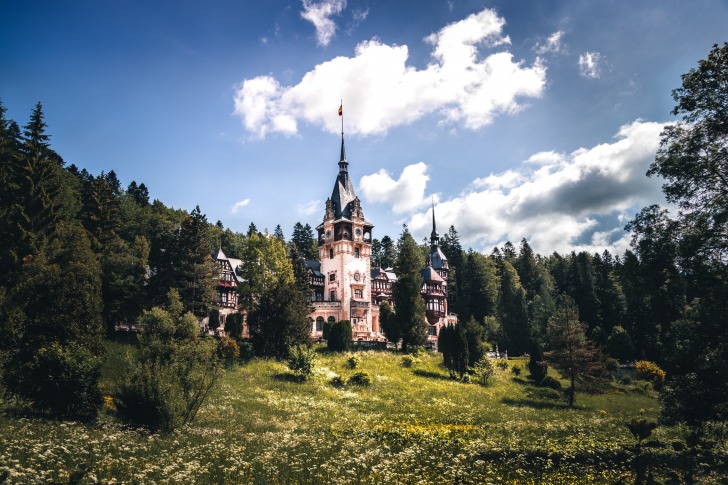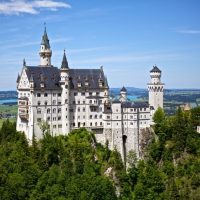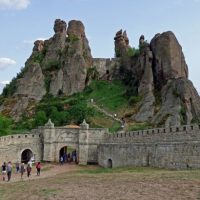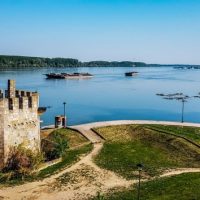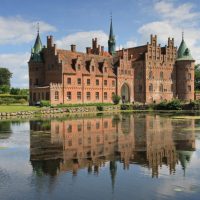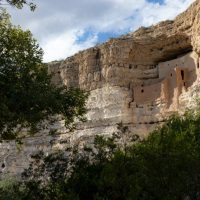Visiting Romania is an opportunity not to be missed. Covered in dense forests, cascading mountains, and beautiful countryside, much of Romania will appear as it would have when many of the famous castles were being built.
Romanian castles are steeped in history and lore, with the legend of Count Dracula and Bran Castle being the most famous.
There are numerous other castles to explore, too, as well as some history to possibly decipher.
For instance, it’s rumored that Vlad the Impaler, the infamous ruler whom Dracula was derived from, never actually visited Bran Castle.
Romania’s economy draws significantly from its tourism, so travelers are sure to find numerous smiling faces and eager ambassadors throughout the country ready to extoll the virtues of this beautiful country.
Today, we’ll find out a bit more about what surprises Romania has to offer for tourists and travelers.
Contents
1. Peleș Castle
First on our list is the neo-Renaissance-style Peleș Castle, located in Sinaia.
Originally built as a summer home for King Carol I and the Royal Family, construction on this citadel began in 1873.
The castle, which has 160 rooms, wasn’t completed until 41 years later.
Peleș Castle remained in the family until 1947 when the communist regime seized control.
After a 20-year stint as a museum, the castle closed its doors in 1975.
The Romanians took back control of this fairy tale castle after the fall of the communist party in the Romanian Revolution of 1989.
This enchanting castle has been meticulously restored; its rooms are filled with fine art and artifacts from across the globe.
Each of its 160 rooms has its own theme.
For example, the Great Salon has an Italian theme and the Music Room’s theme is India.
Peleș Castle, tucked in at the foot of the Bucegi Mountains, was the first castle in Europe to have electricity.
It even has its own power plant!
When you stare at this wondrous palace, one thing is clear – King Carol I spared no expense.
To this day, Peleș Castle is considered one of the most beautiful castles in the world.
2. Bran Castle
Bran Castle, located atop a hill in the town of Brasov, is one of the most famous castles in the world.
While the palace is most famous for being “Dracula’s Castle,” it has a long and storied history.
The first structure on this site was a wooden fortress built in 1211 by the Teutonic Knights.
After the Teutons were driven away in 1226, the original castle fell to ruins.
In 1377, the Saxons of Brașov were permitted to build a castle.
Construction on Bran Castle was completed just 11 years later.
It served as a royal residence for Queen Marie of Romania from 1920 to 1948 – a gift from the Brașov to the Queen.
Bran Castle has a very medieval appearance, with its dark rooms, narrow corridors, and pointed towers.
Today, travelers can wander the grounds and ogle at the furniture and art Queen Marie collected over the years.
It’s the main attraction for travelers visiting Romania and has inspired countless film directors and authors.
3. Clay Castle of the Valley of Fairies
If you plan to visit the mysterious Transylvania when you’re in Romania, add the Clay Castle of the Valley of Fairies to your list of must-see attractions.
Known to locals as the Castelul de Lut Valea Zânelor, the Clay Castle is tucked away in the Southern Carpathians.
It sits along a quiet stream, where you can commune with Romania’s raw nature.
While the Clay Castle of the Valley of Fairies is not a medieval castle, it is truly enchanting.
The hobbit-like castle, built in 2014, is the first 100% eco-friendly palace.
It was made entirely of organic materials, including clay, sand, straw, and wood.
At this time, travelers can only enjoy the castle’s gardens and restaurants.
The restaurant aptly named The Enchanted Garden, keeps the magic alive with its ambiance and fresh, locally-sourced ingredients.
4. Corvin Castle
When you’re in Transylvania, you do not want to miss the Gothic masterpiece called Corvin Castle.
Built by John Hunyadi in the 14th century, this legendary castle is the largest of its kind in Romania.
Also known as Hunyadi Castle or Hunedoara Castle, this palace features a drawbridge, intricate stone carvings, balconies, towers, and turrets.
It’s broken up into three main areas – the Diet Hall, the Knight’s Hall, and the circular staircase.
The two rectangular halls are decorated in marble and painted medallions.
There is much mystery behind this Romanian masterpiece.
It is rumored that John Hunyadi held Vlad the Impaler here for several years.
Another legend surrounding the castle involves the 98-foot well, located near the chapel.
The legend tells that the well was dug by three Turkish prisoners who were told they would be set free when they found water.
After 15 years, the prisoners completed the project, but the jailers did not keep their promise.
Corvin Castle has made it onto several “best of” lists, including “Top European Destination,” “Most Fairytale-Like,” and “Spookiest Castle.”
5. Sturdza Palace
Located in the quaint town of Miclaușeni lies the romantic Sturdza Palace.
Also known as Sturdza Castle, this Baroque and neo-Gothic palace was first constructed between 1880 and 1904 by the Sturdza family.
The palace grounds include a stunning lake and monastery park, with trees that are older than the castle itself.
As you stroll through the grounds, you’ll understand why the castle’s facades are engraved with the words “Utroque clarescere pluchrum,” which translates to “Beauty shines everywhere.”
Sturdza Castle has gone through many transitions throughout its history.
In addition to its many restoration projects, the castle complex has served multiple purposes.
It went from being a residence to an orphanage, hospital, and convent, before settling into its final task – helping to tell Romania’s long and storied history.
6. Cantacuzino Castle
Number six on our list is the neo-Romanian Cantacuzino Castle.
Built in 1911, this remarkable manor served as the Cantacuzino family residence until the Communists took control in 1948.
When the aristocratic family was forced out, its new inhabitants removed the castle’s furnishings and painted over several interior walls.
The estate was returned to the Cantacuzino family in 1989.
It now serves as a museum, where visitors can delve into Romanian history and culture.
While the palace itself is a masterpiece, the grounds are just as impressive.
The gardens and fountains offer a well-earned retreat after exploring the castle’s interior.
7. Banffy Castle
This architectural treasure lies in Bonţida, a small village near Cluj-Napoca.
Banffy Castle is unique because it was constructed in multiple phases.
Its original construction can be traced back to the 15th century.
Over the years, architects made their mark on the palace and gave it several different styles, including Renaissance, Baroque, neo-Classical, and neo-Gothic.
Banffy Castle’s unique architecture, along with its magical royal park, artesian wells, gate, and statues, is why the palace is often referred to as Transylvania’s Versailles Castle
. Throughout its history, the property has served several purposes, including a field hospital, a farm, a driving school, and a children’s hospital.
Today, the castle is protected on the World Monuments Watch List of 100 Most Endangered Sites.
Renovations are done through the Built Heritage Conservation Training Program, which teaches traditional craftsman skills for the repair and restoration of historic sites.
8. Făgăraș Citadel
The historic Făgăraș Citadel was built on the grounds of a wooden fortification from the 12th century.
While its original construction began in 1310, the building was reinforced multiple times over the year.
It fell into enemy hands for a brief period, until Michael the Brave took it back in 1599.
Like other Romanian palaces, Făgăraș Citadel has a mysterious history.
It is rumored that captors of the communist regime were tortured on a device similar to the iron maiden.
Prisoners were forced to kiss a statue with an image of the Holy Mary.
Once they kissed the image, daggers would stab the captor’s body.
Fortunately, the citadel was taken back in 1960.
After serving as a prison for several years, the citadel was turned into a museum and library, where visitors could view Romanian artifacts and learn about the culture of the region.
Romania Safety Overview
READ THE FULL REPORT: Romania Safety Review
Safety Index: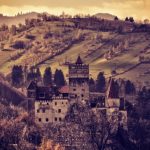
- OVERALL RISK: LOW
- TRANSPORT & TAXIS RISK: LOW
- PICKPOCKETS RISK: LOW
- NATURAL DISASTERS RISK: LOW
- MUGGING RISK: MEDIUM
- TERRORISM RISK: LOW
- SCAMS RISK: MEDIUM
- WOMEN TRAVELERS RISK: LOW
Frequently Asked Questions
Is It Safe to Travel to Romania?
Violent crime is very rare in Romania.
Travelers should exercise the same standard precautions they would when visiting any other country.
These measures include remaining vigilant at all times, particularly when in crowded areas, using public transportation, and when walking alone.
Before you depart, check the U.S. Department of State’s website for current travel advisories.
Do They Speak English in Romania?
Romanian, a Romance language, is the official language of Romania.
The language is similar to Italian and is spoken as the primary language by 91% of Romanians.
However, English is taught in the public school system.
Approximately 29% of the country speaks English.
What Is Considered Rude in Romania?
In Romania, there is a hierarchy based on age and experience.
When speaking with someone of a higher status, treat them with respect.
Do not chew gum or keep your hands in your pocket when addressing someone.
More conservative Romanians cover-up, never exposing their legs or shoulders in public.
What Is the Attitude of the Romanian People?
Romanians are, by nature, quiet and reserved.
They are modest and humble and are drawn to others with the same qualities.
Family is very important to them.
The elderly are treated with respect, as their life experiences bring wisdom that younger generations have yet to experience.
